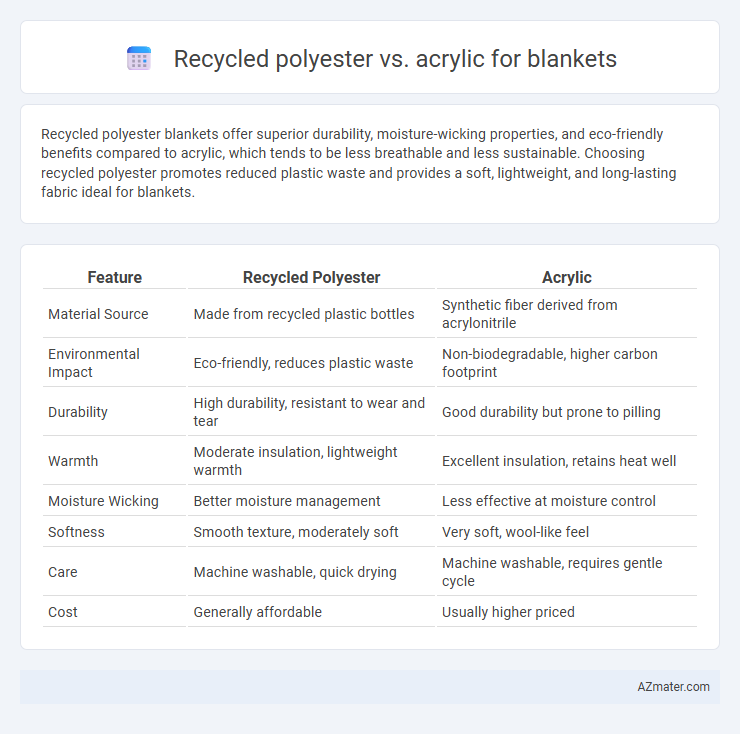Recycled polyester blankets offer superior durability, moisture-wicking properties, and eco-friendly benefits compared to acrylic, which tends to be less breathable and less sustainable. Choosing recycled polyester promotes reduced plastic waste and provides a soft, lightweight, and long-lasting fabric ideal for blankets.
Table of Comparison
| Feature | Recycled Polyester | Acrylic |
|---|---|---|
| Material Source | Made from recycled plastic bottles | Synthetic fiber derived from acrylonitrile |
| Environmental Impact | Eco-friendly, reduces plastic waste | Non-biodegradable, higher carbon footprint |
| Durability | High durability, resistant to wear and tear | Good durability but prone to pilling |
| Warmth | Moderate insulation, lightweight warmth | Excellent insulation, retains heat well |
| Moisture Wicking | Better moisture management | Less effective at moisture control |
| Softness | Smooth texture, moderately soft | Very soft, wool-like feel |
| Care | Machine washable, quick drying | Machine washable, requires gentle cycle |
| Cost | Generally affordable | Usually higher priced |
Understanding Recycled Polyester: What Is It?
Recycled polyester is a sustainable fabric made from post-consumer plastic bottles or industrial polyester waste, reducing environmental impact by diverting plastic from landfills. It offers durability, moisture-wicking properties, and retains warmth, making it an eco-friendly alternative to traditional fibers like acrylic in blankets. Unlike acrylic, recycled polyester provides enhanced breathability and a softer texture, contributing to both comfort and sustainability in textile production.
Acrylic Fiber: Key Characteristics for Blanket Use
Acrylic fiber offers excellent softness, warmth, and lightweight properties, making it ideal for blankets that provide comfort and insulation. It resists moisture, mildew, and UV damage, ensuring durability and easy maintenance in various climates. The fiber's color retention and hypoallergenic nature further enhance its suitability for cozy and long-lasting blankets.
Environmental Impact: Recycled Polyester vs. Acrylic
Recycled polyester blankets significantly reduce environmental impact by utilizing post-consumer plastic waste, lowering carbon emissions, and conserving water compared to virgin polyester. Acrylic production relies on non-renewable petroleum resources and generates higher greenhouse gas emissions and toxic chemical byproducts, causing greater environmental harm. Choosing recycled polyester blankets supports sustainable practices through waste reduction and energy efficiency, making them an eco-friendlier option than acrylic counterparts.
Softness and Comfort Comparison
Recycled polyester blankets offer a smooth, lightweight texture that enhances softness and breathability, making them ideal for prolonged use and sensitive skin. Acrylic blankets tend to be thicker and warmer but can feel coarser and less breathable, which may reduce overall comfort during extended wear. The moisture-wicking properties of recycled polyester contribute to a more comfortable sleep environment compared to the often less absorbent acrylic fibers.
Warmth and Insulation Performance
Recycled polyester offers superior warmth and insulation performance compared to acrylic blankets due to its moisture-wicking properties and high thermal retention. The dense fiber structure of recycled polyester traps body heat effectively, maintaining consistent warmth in colder environments. Acrylic blankets tend to be less efficient at insulating, as their fibers can allow more heat to escape and may retain moisture, reducing overall warmth.
Durability and Longevity
Recycled polyester blankets exhibit superior durability and longevity due to their high resistance to stretching, shrinking, and abrasion compared to acrylic. Acrylic fibers tend to pill and lose shape over time, reducing the blanket's lifespan. The inherent strength of recycled polyester makes it ideal for long-lasting, wear-resistant blankets.
Care and Maintenance Requirements
Recycled polyester blankets require minimal care, often being machine washable and quick-drying with strong resistance to shrinking and stretching, making them durable and easy to maintain. Acrylic blankets, while also machine washable, demand gentler cycles and lower heat settings to prevent pilling and fiber damage, often necessitating air drying or low-heat tumble drying for longevity. Both materials benefit from avoiding bleach and fabric softeners to maintain fiber integrity and softness over time.
Skin Sensitivity and Allergen Considerations
Recycled polyester blankets offer hypoallergenic properties due to their synthetic fibers that resist dust mites and mold, making them ideal for sensitive skin. Acrylic blankets, while soft and warm, can sometimes cause irritation or allergic reactions in individuals with sensitive skin due to their chemical composition. Choosing recycled polyester reduces the risk of skin sensitivity and allergens, promoting a healthier sleeping environment.
Cost Differences and Value for Money
Recycled polyester blankets typically cost more upfront than acrylic ones due to the sustainable production process and eco-friendly materials involved. Despite higher initial prices, recycled polyester offers better durability, moisture-wicking properties, and environmental benefits, providing superior long-term value for money. Acrylic blankets, while cheaper, tend to wear out faster and may require more frequent replacement, making recycled polyester a cost-effective investment over time.
Best Applications: Which Blanket Material Should You Choose?
Recycled polyester blankets offer superior durability, moisture-wicking properties, and eco-friendliness, making them ideal for outdoor use and sustainable living. Acrylic blankets provide excellent warmth, softness, and vibrant color retention, making them suitable for indoor comfort and decorative purposes. Choose recycled polyester for performance and environmental benefits, or acrylic for warmth and aesthetic appeal in cozy indoor settings.

Infographic: Recycled polyester vs Acrylic for Blanket
 azmater.com
azmater.com